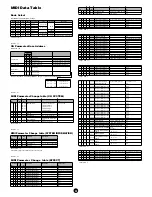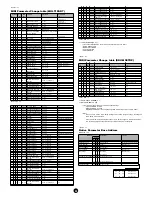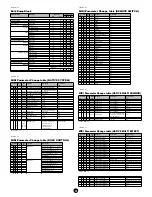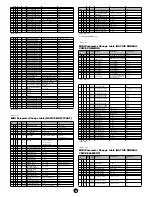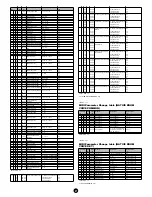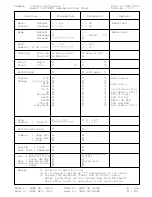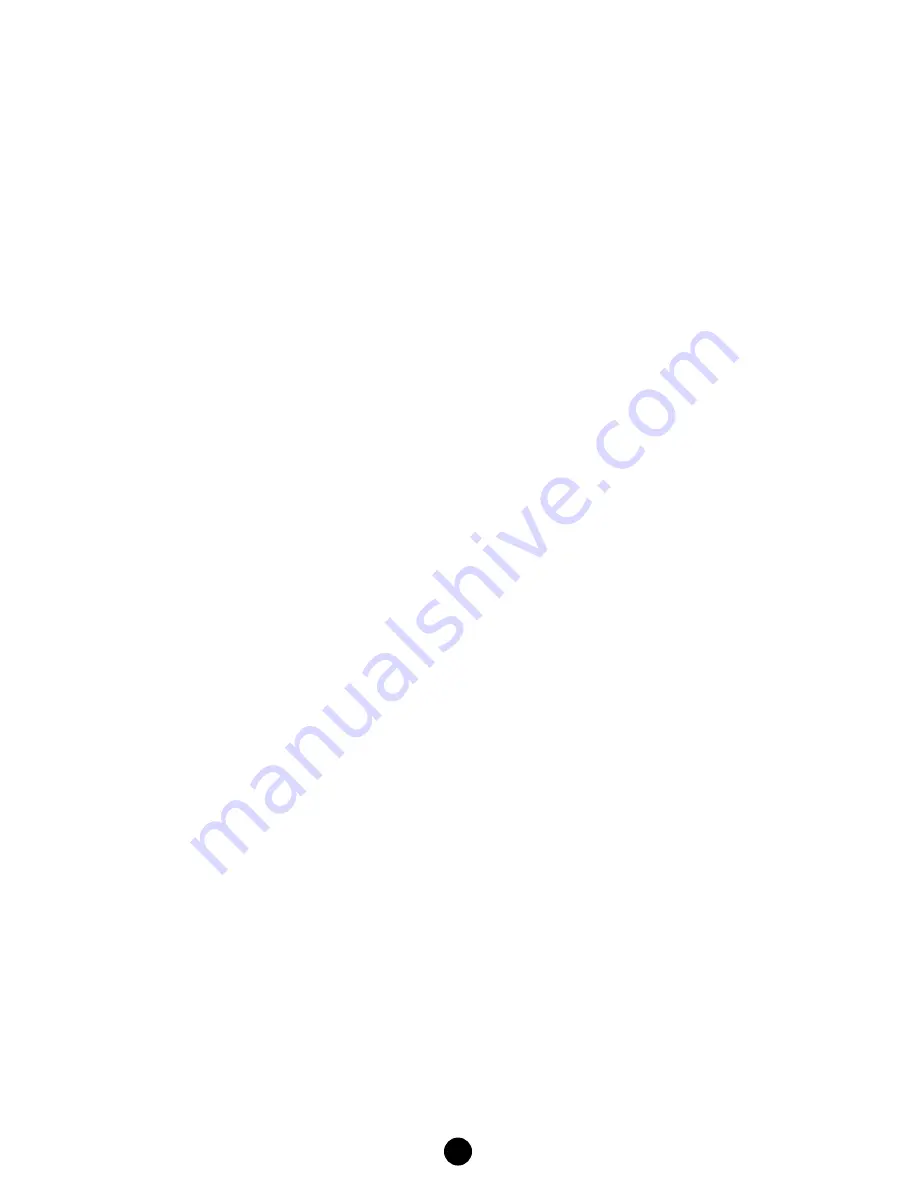
18
MIDI Data Format
1. Channel
messages
1.1
Note on/note off
These messages convey keyboard performance data.
Range of note numbers received = 0 (C-2)...60 (C3)...127 (G8)
Velocity range = 1...127 (Velocity is received only for note-on)
When the Multi Part parameter "Rcv NOTE MESSAGE" = OFF, that part will not receive
these messages.
For a drum part*, key-off is not received if the DrumSetup parameter Rcv NOTE OFF =
OFF.
For a drum part, key-on is not received if the DrumSetup parameter Rcv NOTE ON = OFF.
* Drum Part indicates that the Multi Part parameter PART MODE is "set to DRUM,
DRUMS1, DRUMS2."
1.2 Control
changes
These messages control volume or pan etc.
Their functions are differentiated by the control number (Ctrl#).
If the Multi Part parameter Rcv CONTROL CHANGE = OFF, that part will not receive
control changes.
1.2.1 Bank Select
This message selects the voice bank.
Control#
Parameter
Data Range
0
Bank Select MSB
0, 63, 64, 126, 127
(Normal voice, Native voice, SFX
voice, SFX kit, Drum kit)
32
Bank Select LSB
0...127
The Bank Select data will be processed only after a Program Change is received, and then
voice bank will change at that time.
If you wish to change the voice bank as well as the voice, you must transmit Bank Select
and Program Change messages as a set, in the order of Bank Select MSB, LSB, and
Program Change.
Not received when Receive Bank Select in Native System Parameters is set to off.
1.2.2 Modulation
This message is used primarily to control the depth of vibrato, but the depth of the following
7 types of effect can be controlled.
The effect of this message can be changed by the following parameters.
• Multi Part Parameter
1. MW PITCH CONTROL
2. MW FILTER CONTROL
3. MW AMPLITUDE CONTROL
4. MW LFO PMOD DEPTH
5. MW LFO FMOD DEPTH
6. MW LFO AMOD DEPTH
• Effect1 Parameter
7. MW VARIATION CONTROL DEPTH
(Valid when Variation Effect is assigned to a part as Insertion)
Control#
Parameter
Data Range
1
Modulation
0...127
If the Multi Part parameter Rcv MODULATION = OFF, that part will not receive Modulation.
If the receive channel is a drum part, effects 5 and 6 will not apply.
1.2.3 Portamento Time
This message controls the degree of Portamento (refer to 1.2.9).
Control#
Parameter
Data Range
5
Portamento Time
0...127
When Portamento (control number 065) is ON, this regulates the speed of the pitch
change.
A value of 0 is the shortest portamento time, and 127 is the longest portamento time.
If the receive channel is a drum part, Portamento Time is not received.
1.2.4 Data Entry
This message sets the value of the parameter which was specified by RPN MSB/LSB (see
1.2.22) and NRPN MSB/LSB (see 1.2.21).
Control#
Parameter
Data Range
6
Data Entry MSB
0...127
38
Data Entry LSB
0...127
1.2.5 Main Volume
This message controls the volume of each part.
This is used to adjust the volume balance between parts.
Control#
Parameter
Data Range
7
Main Volume
0...127
When the Multi Part parameter Rcv VOLUME = OFF, that part will not receive Main
Volume.
With a value of 0 there will be no sound, and a value of 127 will be the maximum volume.
1.2.6 Panpot
This message control the panning (stereo location) of each part.
Control#
Parameter
Data Range
10
Pan
0...64...127
When the Multi Part parameter Rcv PAN = OFF, that part will not receive Panpot.
0 is left, 64 is center, and 127 is right.
1.2.7 Expression
This message controls expression (dynamics within a musical line) for each part.
It is used to create volume changes during a song.
Control#
Parameter
Data Range
11
Expression
0...127
If the Multi Part parameter Rcv EXPRESSION = OFF, that part will not receive Expression.
1.2.8 Hold1
This message controls sustain pedal on/off.
Control#
Parameter
Data Range
64
Hold1
0...63,64...127
(OFF, ON)
When this is ON, currently-sounding notes will continue to sound even if note-off
messages are received.
If the Multi Part parameter Rcv HOLD1 = OFF, that part will not receive Hold1.
1.2.9 Portamento
This message controls portamento on/off.
Control#
Parameter
Data Range
65
Portamento
0...63,64...127
(OFF, ON)
When this is ON, the pitch will change smoothly between notes. The time over which the
pitch changes is adjusted by Portamento Time (see 1.2.3). Also, when the Multi Part
parameter MONO/POLY MODE = MONO, the tone will also change smoothly (legato) if
Portamento = ON.
If any of the following Multi Part parameter settings apply, that part will not receive
Portamento.
• Rcv PORTAMENTO = OFF
• PART MODE=DRUM, DRUMS1, 2
1.2.10 Sostenuto
This message controls sostenuto pedal on/off.
Control#
Parameter
Data Range
66
Sostenuto
0...63,64...127
(OFF, ON)
If sostenuto is turned on while a note is sounding, that note will be sustained until
sostenuto is turned OFF.
Sostenuto for the specified part is not received when Rcv SOSTENUTO of the part in Multi
Part Parameters is set to off.
1.2.11 Soft Pedal
This message controls soft pedal on/off.
Control#
Parameter
Data Range
67
Soft Pedal
0...63,64...127
(OFF, ON)
The sound will become mellower when Soft Pedal is ON.
If any of the following Multi Part parameter settings apply, that part will not receive the Soft
Pedal.
• Rcv SOFT PEDAL=OFF
• PART MODE=DRUMÅA DRUMS1ÅA2
1.2.12 Harmonic Content
This message adjusts the resonance of the filter that is specified for the sound.
Control#
Parameter
Data Range
71
Harmonic Content
0...64...127
(-64...0...+63)
Since this is a relative change parameter, it specifies a boost or cut relative to 64.
Higher values will produce a more distinctive sound.
For some sounds, the effective range may be less than the possible range of settings.
1.2.13 Release Time
This message adjusts the EG release time that was specified by the sound data.
Control#
Parameter
Data Range
72
Release Time
0...64...127
(-64...0...+63)
Since this is a relative change parameter, it specifies an increase or decrease relative to
64.
Increasing this value will lengthen the release that follows a note-off.
1.2.14 Attack Time
This message adjusts the EG attack time that was specified by the sound data.
Control#
Parameter
Data Range
73
Attack Time
0...64...127
(-64...0...+63)
Since this a relative change parameter, it specifies an increase or decrease relative to 64.
Increasing this value will make the attack more gradual, and decreasing this value will
make the attack sharper.
1.2.15 Brightness
This message adjusts the cutoff frequency of the low pass filter specified by the sound
data.
Control#
Parameter
Data Range
74
Brightness
0...64...127
(-64...0...+63)
Since this is a relative change parameter, it specifies an increase or decrease relative to
64.
Lower values will produce a more mellow sound.
For some sounds, the effective range may be less than the possible range of settings.




















